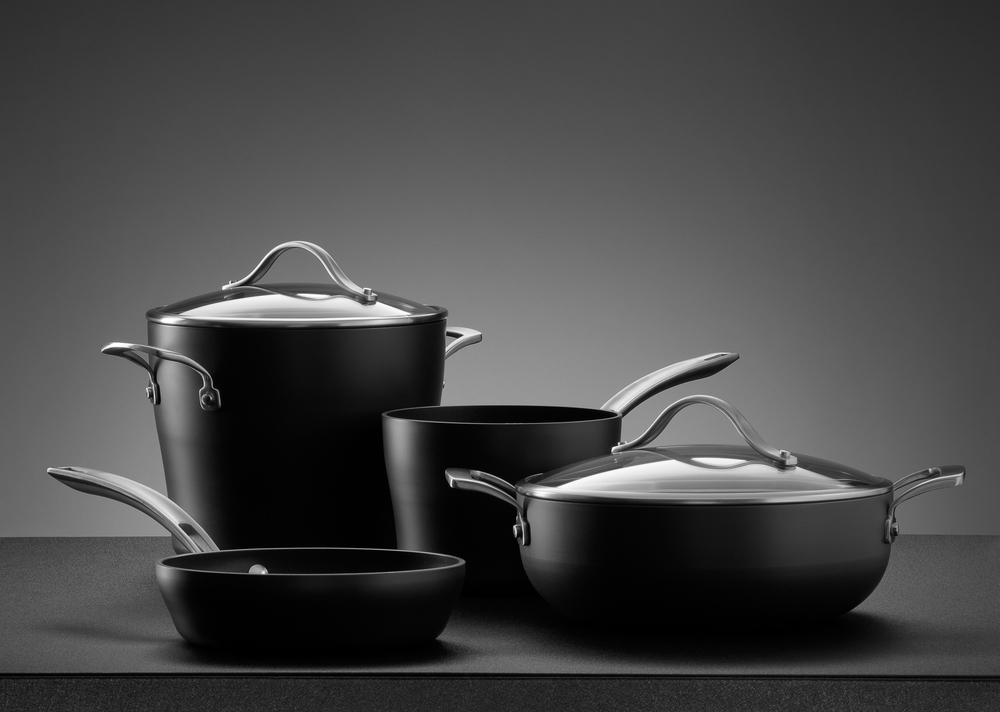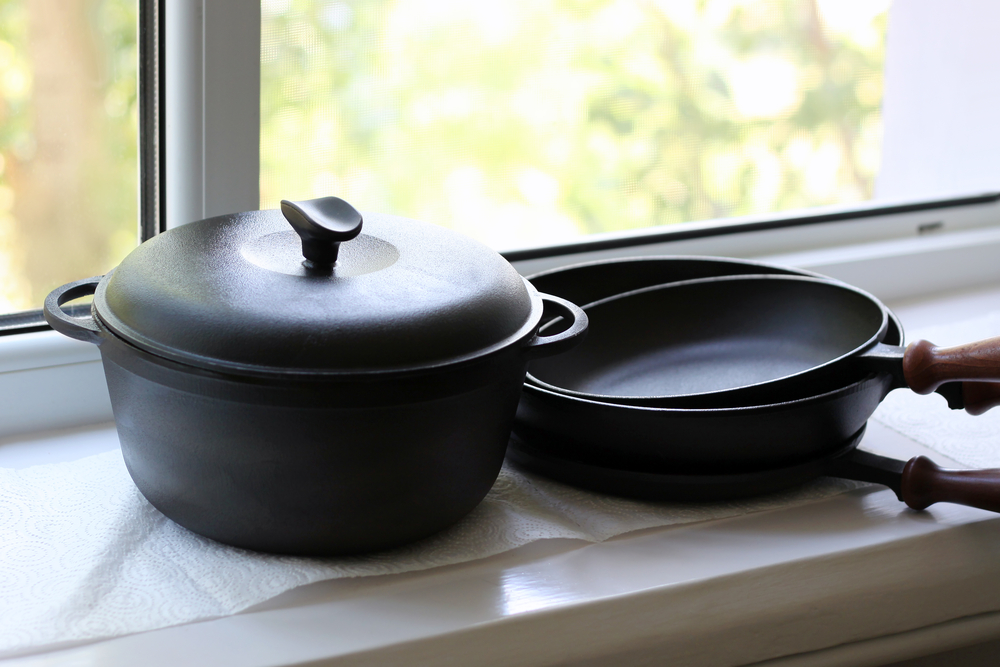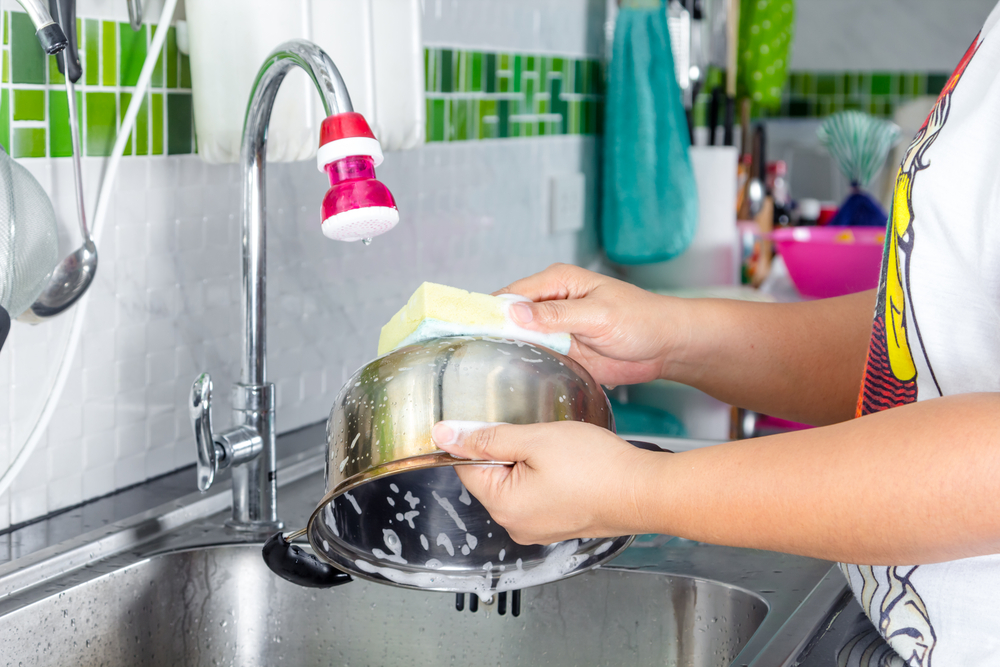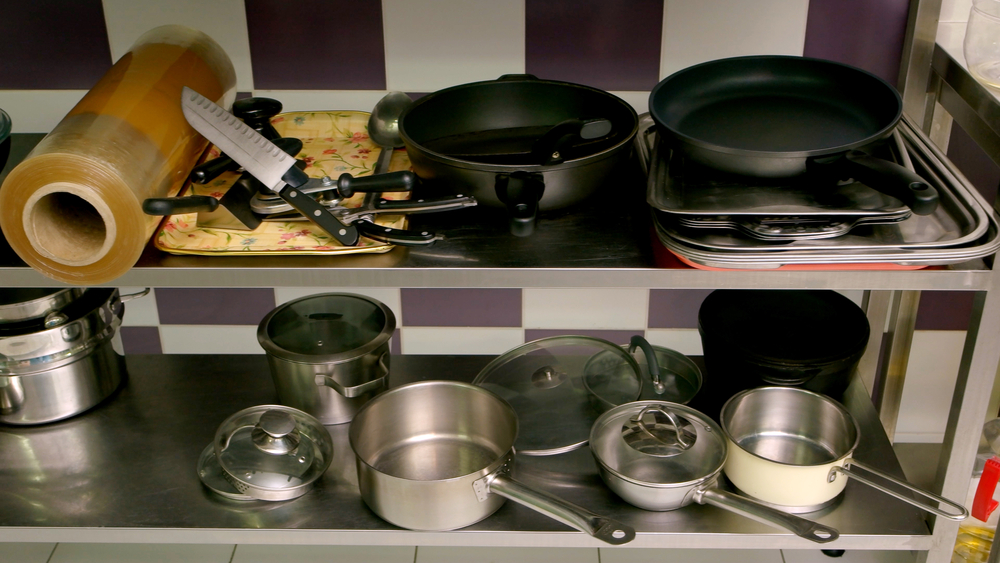I have always been a fan of slow-cooked meals that are packed with flavor and aroma. One of the most versatile and essential cookware that I use in my kitchen is the braising pan.
If you are not familiar with this type of pan, you are missing out on a lot of delicious meals that you can easily prepare at home.
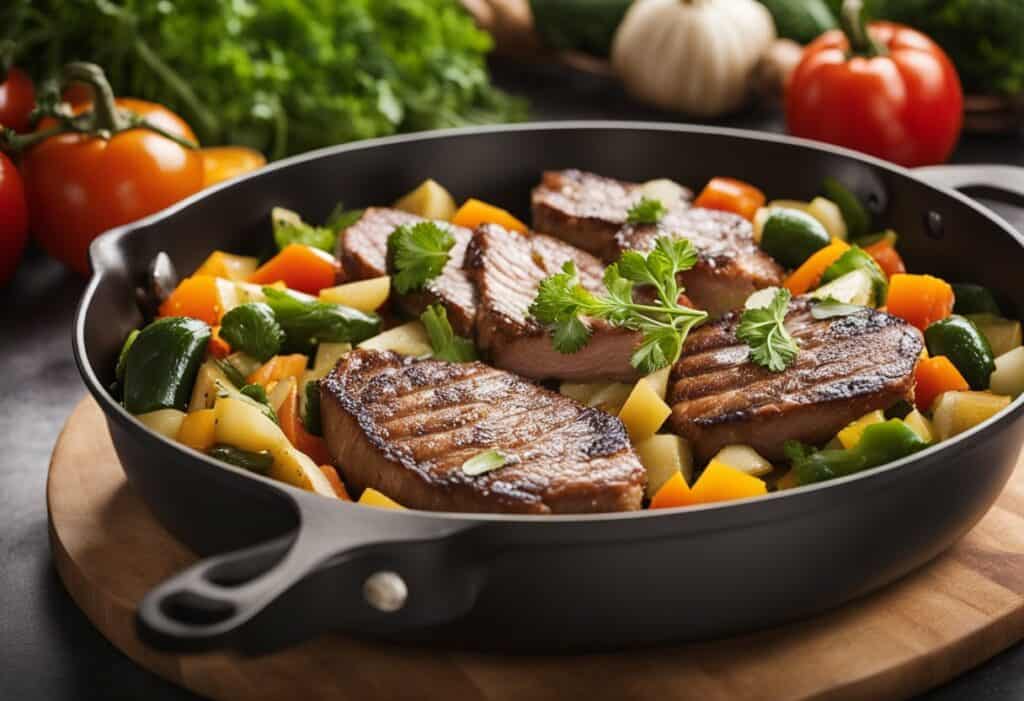
A braising pan is a type of cookware that is designed for braising, a cooking technique that involves browning meat or vegetables in oil and then slowly cooking them in a covered pot with a small amount of liquid.
Braising pans are typically made of heavy-duty materials such as cast iron, stainless steel, or copper, which allows them to withstand high temperatures and distribute heat evenly.
They come in different sizes, shapes, and designs to fit various cooking needs and preferences.
Key Takeaways
- A braising pan is a versatile cookware that is designed for braising, a cooking technique that involves browning meat or vegetables in oil and then slowly cooking them in a covered pot with a small amount of liquid.
- Braising pans are typically made of heavy-duty materials such as cast iron, stainless steel, or copper, which allows them to withstand high temperatures and distribute heat evenly.
- Braising pans come in different sizes, shapes, and designs to fit various cooking needs and preferences.
What is a Braising Pan?
As a professional chef, I often get asked about different types of cookware, and one that comes up a lot is the braising pan.
A braising pan is a large, heavy-duty cooking vessel that is specifically designed for braising. It is a versatile piece of cookware that can be used on both the stove and in the oven.
Braising pans typically have a large surface area, which makes them ideal for browning meat and vegetables.
They are also deeper than a standard frying pan, which allows for the addition of liquid and other ingredients. This makes them perfect for slow-cooking dishes like stews, casseroles, and pot roasts.
When it comes to choosing the right braising pan, there are a few things to consider. First, you want to make sure that it is made from a durable material that can withstand high heat and frequent use.
Stainless steel and cast iron are both popular choices for braising pans.
Another important factor to consider is the size of the pan. You want to choose a pan that is large enough to accommodate the amount of food you will be cooking.
A pan that is too small will not allow for proper browning and may result in overcrowding, which can affect the final outcome of your dish.
Overall, a braising pan is an essential piece of cookware for any home cook or professional chef. Its versatility and durability make it a worthwhile investment that will last for years to come.
Key Features of a Braising Pan

As a professional chef, I know that a braising pan is an essential tool in the kitchen. It is a versatile piece of cookware that is perfect for slow-cooking meats, vegetables, and other dishes.
In this section, I will discuss the key features of a braising pan.
Size and Shape
Braising pans come in various sizes and shapes, including round, square, and rectangular. The size and shape of the pan you choose will depend on the amount of food you plan to cook.
Round pans are ideal for cooking small to medium-sized portions, while rectangular pans are better suited for larger quantities.
Material
Braising pans can be made from a variety of materials, including cast iron, enameled cast iron, stainless steel, and enamel.
Cast iron and enameled cast iron are popular choices because they distribute heat evenly and retain heat well. Stainless steel is durable and easy to clean, while enamel is non-reactive and resistant to stains.
Handles and Lid
Braising pans come with different types of handles, including loop handles and side handles. Loop handles are ideal for lifting the pan with both hands, while side handles are easier to grip with one hand.
The lid is also an important feature of a braising pan. A tight-fitting lid helps to trap in moisture and flavor, while also preventing spills and splatters.
Overall, a braising pan is a versatile and essential tool in any kitchen. Whether you are slow-cooking meats, vegetables, or other dishes, a braising pan is the perfect tool for the job.
The Braising Process
As a cooking method, braising is a great way to achieve tender, flavorful meat and vegetables. It involves two distinct processes: searing and simmering.
Searing
Searing is the first step in braising. It involves cooking the meat or vegetables quickly over high heat to brown the exterior and create a flavorful crust.
This is typically done in a braising pan or Dutch oven with a small amount of oil. The searing process also helps to lock in the juices and keep the meat moist during the slow cooking process.
Simmering
After searing, the meat or vegetables are then simmered in a liquid over low heat for an extended period of time.
This allows the flavors to meld together, and the meat to become tender and juicy. The liquid can be a variety of things, such as broth, wine, or tomato sauce, depending on the recipe.
Braising is a popular cooking method for dishes such as coq au vin, pot roast, and stews. It is a slow cooking process that requires patience, but the end result is well worth it.
When searing, it is important to use a pan that provides even heat distribution and a high enough temperature to achieve a good sear. A braising pan or Dutch oven is typically the best choice for this.
When simmering, it is important to keep the liquid at a gentle simmer, not a rapid boil. This allows the meat to cook slowly and become tender.
Overall, braising is a great cooking method for achieving tender, flavorful meat and vegetables. With the right tools and a little patience, anyone can master this technique.
Common Foods Cooked in a Braising Pan

When it comes to cooking, braising pans are one of the most versatile tools in the kitchen. They are perfect for cooking a wide variety of dishes, from meat to vegetables to soups and casseroles.
Here are some common foods that can be cooked in a braising pan.
Meat Dishes
Braising pans are perfect for cooking meat dishes, as they allow for slow, even cooking that results in tender and flavorful meat.
Some popular meat dishes that can be cooked in a braising pan include pot roast, meatballs, sausages, and roast chicken.
To cook meat in a braising pan, first sear the meat on all sides to lock in the juices, then add liquid and simmer until the meat is cooked through.
Vegetable Dishes
Braising pans are also great for cooking vegetables, as they allow for even cooking and help to retain the natural flavors and nutrients of the vegetables.
Some popular vegetable dishes that can be cooked in a braising pan include tomatoes, rice, pasta, and stir fry dishes.
To cook vegetables in a braising pan, sauté them in oil until they are tender, then add liquid and simmer until they are cooked through.
Other Dishes
In addition to meat and vegetable dishes, braising pans can also be used to cook a wide variety of other dishes, including casseroles, soups, and chili. Braising pans are perfect for making these types of dishes, as they allow for slow, even cooking that results in tender and flavorful food.
To cook these types of dishes in a braising pan, simply add all of the ingredients to the pan, cover, and simmer until everything is cooked through.
Braising Pan Brands
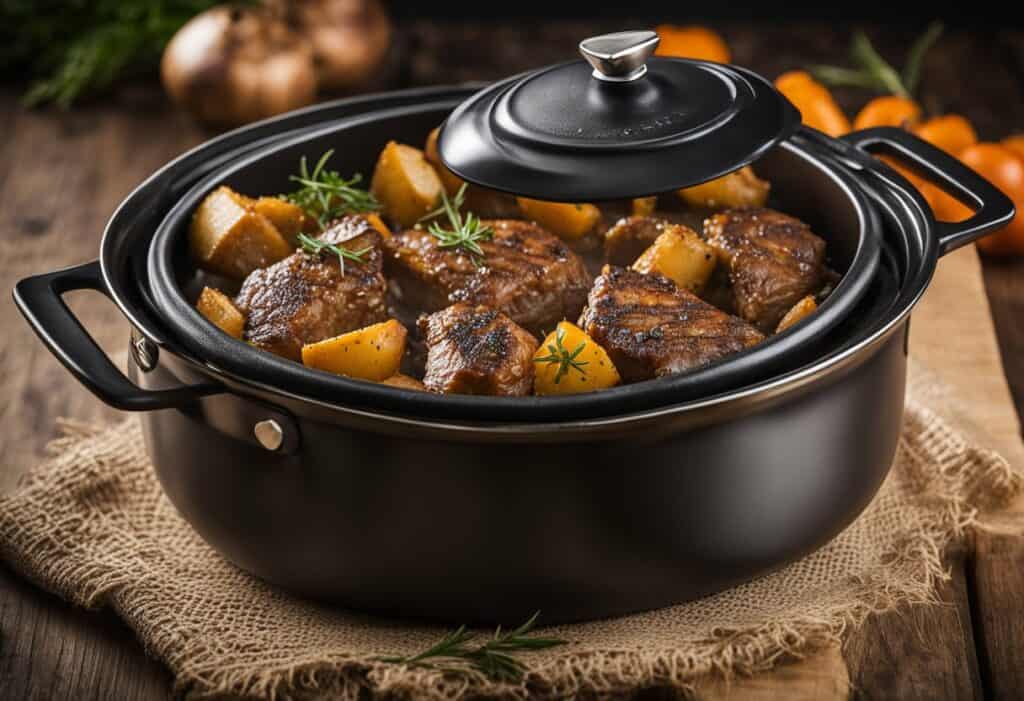
When it comes to braising pans, there are a few brands that stand out in terms of quality and durability. Here are some of the top braising pan brands and what makes them great:
Le Creuset
Le Creuset is a well-known and respected brand in the cookware world, and their braising pans are no exception. Made from high-quality enameled cast iron, Le Creuset’s braising pans are durable, heat evenly, and retain heat well.
They come in a variety of sizes and colors to match any kitchen decor. While they can be a bit pricey, they are definitely worth the investment.
Staub
Staub is another top brand when it comes to braising pans. Their pans are made from cast iron and are coated with enamel for added durability.
Staub’s braising pans are known for their unique design, which includes spikes on the lid that help to distribute moisture evenly throughout the dish.
This results in tender, flavorful meat every time. Staub’s pans also come in a variety of sizes and colors to match any kitchen decor.
Lodge
If you’re looking for a more budget-friendly option, Lodge is a great brand to consider. Their braising pans are made from cast iron and are pre-seasoned, so they’re ready to use right out of the box.
While they may not have all the bells and whistles of some of the more expensive brands, Lodge’s braising pans are still durable and effective.
Plus, they come in a variety of sizes and are made in the USA.
Overall, when it comes to braising pans, it’s important to choose a brand that’s known for quality and durability.
Whether you go with a high-end brand like Le Creuset or Staub, or a more budget-friendly option like Lodge, a good braising pan is an investment that will last for years to come.
Cleaning and Maintenance
As someone who has worked in the foodservice industry for several years, I know how important it is to properly clean and maintain kitchen equipment.
Braising pans are no exception. Here are some tips for cleaning and maintaining your braising pan:
Daily Care
It is essential to clean your braising pan after each use to prevent food buildup and maintain its longevity. Here are some steps to follow:
- Wipe down the exterior of the pan with a damp cloth.
- Clean the interior of the pan with soap and water, using a non-abrasive sponge or cloth.
- Rinse the pan thoroughly with hot water.
- Dry the pan with a clean towel.
Avoid using harsh chemicals that may damage the stainless steel.
Quarterly Maintenance
In addition to daily care, it is important to perform quarterly maintenance on your braising pan. Here are some steps to follow:
- Inspect the pan for any signs of damage, such as scratches or dents.
- If there are any scratches or dents, contact a professional for repair.
- Check the pan’s handles and knobs to make sure they are secure.
- Lubricate the pan’s hinges and locks with food-grade oil.
- If there is any buildup or discoloration on the pan, use a non-abrasive cleaner and follow the manufacturer’s instructions.
By following these cleaning and maintenance tips, you can ensure that your braising pan lasts for many years to come.
Special Types of Braising Pans
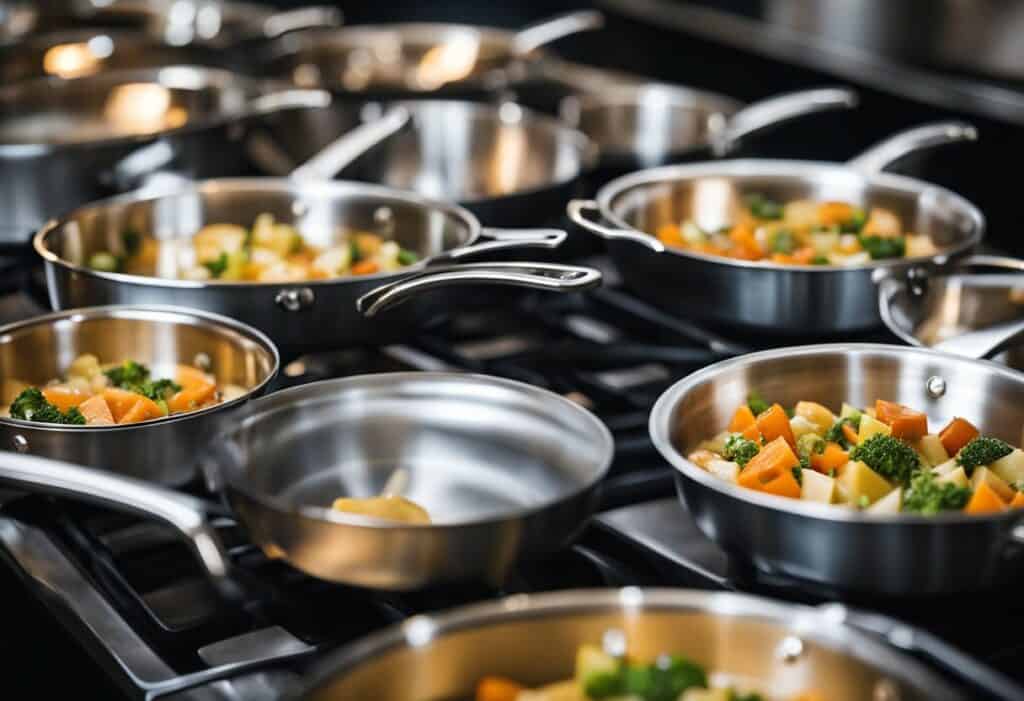
When it comes to braising pans, there are a few special types that are worth mentioning.
These pans are designed to meet specific needs and requirements, and they can be a great addition to any kitchen that requires specialized equipment.
Pressure Braising Pans
Pressure braising pans are a type of braising pan that utilizes pressure to cook food quickly and efficiently. These pans are ideal for high-volume institutional applications where speed and efficiency are essential.
They are also great for kitchens with limited space, as they can often be used as a replacement for multiple pieces of equipment.
One of the main benefits of pressure braising pans is that they can reduce cooking times by up to 70%. This can be a huge advantage in busy kitchens where time is of the essence.
Additionally, pressure braising pans often come equipped with safety features, such as automatic pressure release valves and locking lids, which make them safe and easy to use.
Tilting Skillets
Tilting skillets, also known as tilting braising pans, are a type of braising pan that can be tilted to pour out liquids or solids.
These pans are often used in institutional applications where large quantities of food need to be cooked and served quickly.
One of the main benefits of tilting skillets is that they can be used for a variety of cooking methods, including braising, frying, and sautéing.
They are also available in a range of sizes, from small countertop models to large 30-gallon pans.
In addition to their versatility, tilting skillets are also designed to be easy to use and clean.
They often come equipped with features such as automatic tilt locks, which keep the pan in place while it is being filled or emptied, and removable heating elements, which make cleaning a breeze.
Overall, both pressure braising pans and tilting skillets can be valuable additions to any kitchen that requires specialized equipment.
Whether you are cooking for a high-volume institutional application or simply need a versatile and easy-to-use braising pan, these specialized pans are definitely worth considering.
Conclusion

In conclusion, a braising pan is a versatile piece of cookware that is essential for any kitchen. It is a wide, shallow pan with sloping sides that is perfect for browning and searing meat and vegetables.
The wide surface area of the pan allows for even heat distribution, ensuring that food is cooked evenly and thoroughly.
Braising pans come in different sizes and materials, so it is important to choose the right one for your needs.
Stainless steel and cast iron are popular materials because they are durable and retain heat well. Non-stick coatings are also available, but they may not be as durable as other materials.
When using a braising pan, it is important to follow the proper cooking techniques. Searing the meat or vegetables first will help to lock in the flavor and juices, while simmering the food in liquid will help to tenderize it and infuse it with flavor.
Braising is a slow cooking method, so it is important to be patient and allow the food to cook slowly and evenly.
Overall, a braising pan is a must-have for any serious cook. Whether you are a professional chef or a home cook, a braising pan will help you to create delicious, flavorful meals that are sure to impress.
So if you don’t already have one in your kitchen, it’s time to invest in one today!
Frequently Asked Questions
What is the difference between a braising pan and a Dutch oven?
A braising pan is a large, flat-bottomed pan with high sides that is used for searing and then slow-cooking food in liquid. A Dutch oven is a heavy, deep pot with a tight-fitting lid that is used for cooking stews, soups, and braises.
While both can be used for braising, a braising pan is typically more shallow and has a larger surface area, making it better for searing and reducing liquids.
What is the purpose of a braiser pan?
A braiser pan is designed for braising, which is a cooking technique that involves searing food at a high temperature and then cooking it slowly in liquid at a lower temperature.
This method helps to tenderize tough cuts of meat and infuse them with flavor.
What type of pan is best for braising?
A braising pan is the best type of pan for braising because of its large surface area, high sides, and flat bottom.
Other types of pans, such as a Dutch oven or a deep skillet, can also be used for braising, but a braising pan is specifically designed for this cooking method.
What are the advantages of using a stainless steel braising pan?
Stainless steel braising pans are durable, easy to clean, and can be used on any type of stovetop, including induction.
They are also non-reactive, which means they won’t react with acidic ingredients like tomatoes or wine.
What are the benefits of using a large braising pan?
A large braising pan allows you to cook a larger quantity of food at once, which is great for feeding a crowd or meal prepping.
It also provides a larger surface area for searing, which helps to develop a rich, flavorful crust on the food.
What are some alternatives to using a braising pan?
If you don’t have a braising pan, you can use a Dutch oven, a deep skillet, or even a slow cooker to braise food.
However, keep in mind that the cooking times and liquid amounts may need to be adjusted based on the size and shape of the pan.


